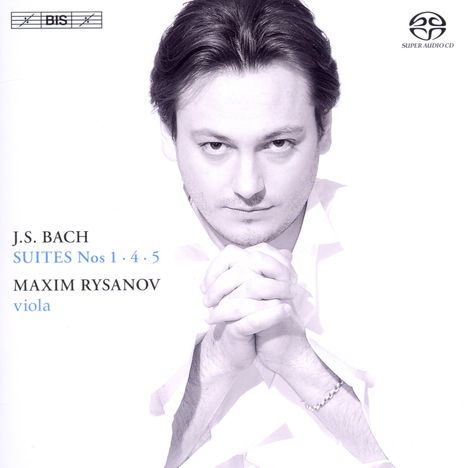Johann Sebastian Bach: Cellosuiten BWV 1007,1010,1011 (arr.für Viola) auf Super Audio CD
Cellosuiten BWV 1007,1010,1011 (arr.für Viola)
Die SACD verwendet eine höhere digitale Auflösung als die Audio-CD und bietet außerdem die Möglichkeit, Mehrkanalton (Raumklang) zu speichern. Um die Musik in High-End-Qualität genießen zu können, wird ein spezieller SACD-Player benötigt. Dank Hybrid-Funktion sind die meisten in unserem Shop mit "SACD" gekennzeichneten Produkte auch auf herkömmlichen CD-Playern abspielbar. Dann allerdings unterscheidet sich der Sound nicht von einer normalen CD. Bei Abweichungen weisen wir gesondert darauf hin (Non-Hybrid).

- Tonformat:
- stereo & multichannel (Hybrid)
- Künstler:
- Maxim Rysanov, Viola
- Label:
- BIS
- Aufnahmejahr ca.:
- 2009/2010
- Artikelnummer:
- 1638657
- UPC/EAN:
- 7318599917832
- Erscheinungstermin:
- 18.8.2010
In ihren ersten 200 Jahren führten Bachs Cellosuiten eine merkwürdige, etwas obskure Existenz. Zu ihrer Entstehungszeit, um 1720, galten solche Werke schon als etwas old fashioned, und viele der verwendeten Tanzmodelle waren aus der Mode gekommen. Darüber hinaus galt das Cello „nur“ als Continuo-Instrument, das sich nicht solistisch in den Vordergrund zu drängen hatte. Spätere Generationen empfanden die solistische Linie des Cellos als unvollkommen, was z. B. Robert Schumann veranlasste, eine Klavierbegleitung zu komponieren.
Erst Pablo Casals verhalf den Werken zu ihrem Recht; er war der erste, der sie konsequent in Konzerten spielte. Schon bald, 1916, erschien die erste Ausgabe in einer Bearbeitung für Viola. Rysanov, am Beginn einer vielversprechenden Karriere stehend (Young Artist of the Year 2008) hat sich für diese Einspielung die erste, vierte und fünfte Suite ausgesucht, Werke, von denen Casals einst sagte: „Die Suiten sind die Essenz von Bach, und Bach ist die Essenz von Musik.“
During their first 200 years, Johann Sebastian Bach's solo suites for cello led a curiously obscure existence. By 1720, the time of their composition, suites of their kind were already beginning to seem slightly outdated, and many of the dances which in stylized form appear in them were going out of fashion. Furthermore, the cello was generally regarded as a continuo instrument, and pieces allowing it a more prominent role were few and far between. In consequence, the suites were rarely performed - especially in their entirety - and rather treated as more suited for teaching the instrument. They were also often regarded as incomplete, and the fact that Schumann, among others, attempted to provide them with piano accompaniments serves as an illustration of how foreign the concept of solo works for the cello remained. It is Pablo Casals who is credited with the rediscovery of the cello suites: encountering them in the 1890's, he first brought them to the concert hall around the turn of the century. Soon after, in 1916, came the first published edition of the suites arranged for the viola. But again they were mainly seen as learning aids for budding violists, and it is only during the past decades that they have become part of the concert and recording repertoire of international soloists on the instrument. The latest of these is the highly regarded Ukrainian-born violist Maxim Rysanov, who in 2008 received a Gramophone Award as 'Young Artist of the Year'. Rysanov's career has developed rapidly, with acclaimed recordings and high profile appearances, including the Last Night of the BBC Proms in 2010. For his first recording for BIS he has selected the first, fourth and fifth of Bach's suites - these works of which Casals once wrote: 'They are the very essence of Bach, and Bach is the essence of music.'
Disk 1 von 1 (SACD)
Suite für Violoncello solo Nr. 4 Es-Dur BWV 1010 (für Viola bearb. von S. Rowland-Jones)
-
1 1. Prélude
-
2 2. Allemande
-
3 3. Courante
-
4 4. Sarabande
-
5 5. Bourrée 1 - Bourrée 2
-
6 6. Gigue
Suite für Violoncello solo Nr. 5 c-moll BWV 1011 (für Viola bearb. von S. Rowland-Jones)
-
7 1. Prélude
-
8 2. Allemande
-
9 3. Courante
-
10 4. Sarabande
-
11 5. Gavotte 1 - Gavotte 2
-
12 6. Gigue
Suite für Violoncello solo Nr. 1 G-Dur BWV 1007 (für Viola bearb. von S. Rowland-Jones)
-
13 1. Prélude
-
14 2. Allemande
-
15 3. Courante
-
16 4. Sarabande
-
17 5. Menuet 1 - Menuet 2
-
18 6. Gigue
Mehr von Johann Sebastia...
-
Johann Sebastian BachMesse h-moll BWV 2322 Super Audio CDsVorheriger Preis EUR 19,99, reduziert um 0%Aktueller Preis: EUR 14,99
-
Johann Sebastian BachDie apokryphen Werke8 CDsVorheriger Preis EUR 39,99, reduziert um 0%Aktueller Preis: EUR 29,99
-
Bach Family - Geistliche Musik der Bach-FamilieCDVorheriger Preis EUR 14,99, reduziert um 0%Aktueller Preis: EUR 7,99
-
Mitteldeutsche Hornkonzerte - Musik aus Bachs NetzwerkCDAktueller Preis: EUR 17,99






